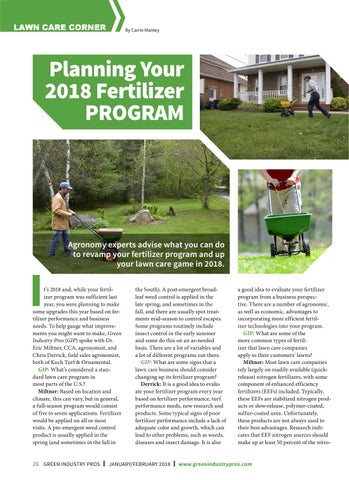LAWN CARE CORNER
By Carrie Mantey
Planning Your 2018 Fertilizer PROGRAM
I
Agronomy experts advise what you can do to revamp your fertilizer program and up your lawn care game in 2018.
t’s 2018 and, while your fertilizer program was sufficient last year, you were planning to make some upgrades this year based on fertilizer performance and business needs. To help gauge what improvements you might want to make, Green Industry Pros (GIP) spoke with Dr. Eric Miltner, CCA, agronomist, and Chris Derrick, field sales agronomist, both of Koch Turf & Ornamental. GIP: What’s considered a standard lawn care program in most parts of the U.S.? Miltner: Based on location and climate, this can vary, but in general, a full-season program would consist of five to seven applications. Fertilizer would be applied on all or most visits. A pre-emergent weed control product is usually applied in the spring (and sometimes in the fall in
26 GREEN INDUSTRY PROS
GIP0118_26-27_LawncareFeature.indd 26
❙
the South). A post-emergent broadleaf weed control is applied in the late spring, and sometimes in the fall, and there are usually spot treatments mid-season to control escapes. Some programs routinely include insect control in the early summer and some do this on an as-needed basis. There are a lot of variables and a lot of different programs out there. GIP: What are some signs that a lawn care business should consider changing up its fertilizer program? Derrick: It is a good idea to evaluate your fertilizer program every year based on fertilizer performance, turf performance needs, new research and products. Some typical signs of poor fertilizer performance include a lack of adequate color and growth, which can lead to other problems, such as weeds, diseases and insect damage. It is also
JANUARY/FEBRUARY 2018
❙
a good idea to evaluate your fertilizer program from a business perspective. There are a number of agronomic, as well as economic, advantages to incorporating more efficient fertilizer technologies into your program. GIP: What are some of the more common types of fertilizer that lawn care companies apply to their customers’ lawns? Miltner: Most lawn care companies rely largely on readily available (quickrelease) nitrogen fertilizers, with some component of enhanced efficiency fertilizers (EEFs) included. Typically, these EEFs are stabilized nitrogen products or slow-release, polymer-coated, sulfur-coated urea. Unfortunately, these products are not always used to their best advantages. Research indicates that EEF nitrogen sources should make up at least 50 percent of the nitro-
www.greenindustrypros.com
2/6/18 11:09 AM
